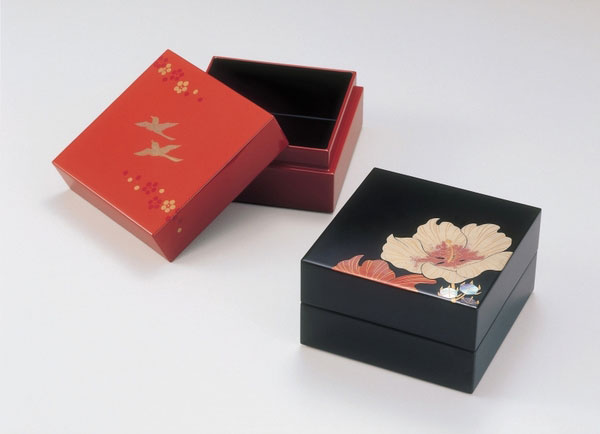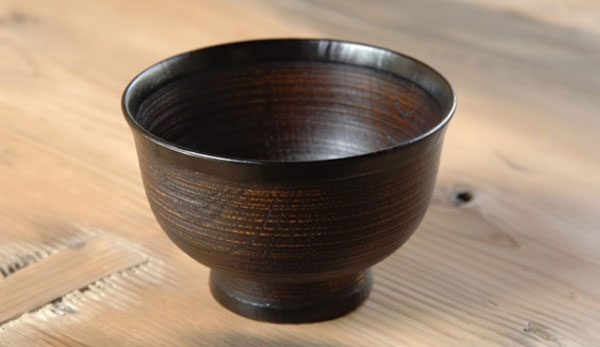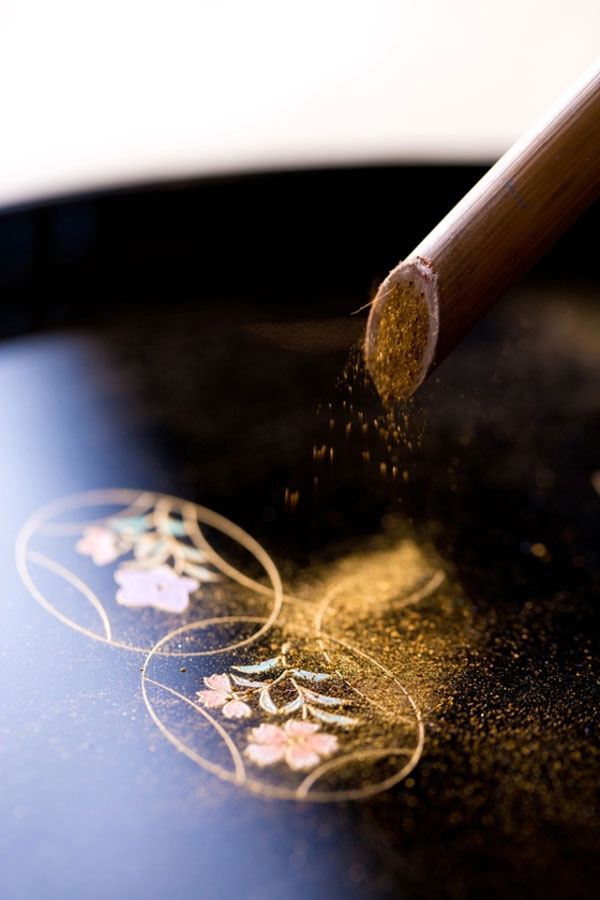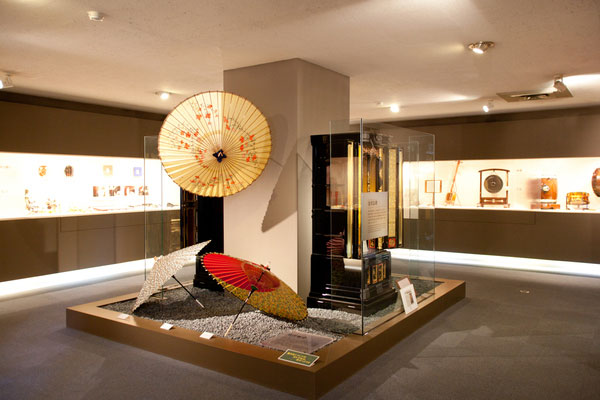 Photo:Ishikawa Prefecture Tourism League
Photo:Ishikawa Prefecture Tourism League
- Lacquerware
- Ishikawa
Kanazawa lacquerware Kanazawa shikki
Delicate, wonderful, Kyoto-style gold and silver lacquer
The elegance of the aristocracy mixed with the strength of samurai warriors
Description
What is Kanazawa lacquerware ?
Kanazawa lacquerware (called Kanazawa shikki in Japanese) is produced in the area around the city of Kanazawa, in Ishikawa prefecture. It was developed for the liking of feudal lords as it had the financial backing of the Kaga domain (present day Kanazawa). This domain was so large and wealthy that it was described as hyakumangoku, or having the ability to produce a million koku (180 litres) of rice.
This craft has unparalleled levels of quality and magnificence due to its use of maki-e, a lacquerware decoration technique in which designs are made by sprinkling powder of gold, silver, or other colors onto a lacquer drawing. While lacquerware is said to have originally been imported from China, maki-e first developed in Japan. The maki-e used for Kanazawa lacquerware in particular has brought together many of the maki-e techniques used today, including hiramaki-e (flat gold/silver lacquer), tokidashi maki-e (gold/silver lacquer polished to finish), takamaki-e (embossed gilt lacquer work), and shishiai tokidashi maki-e (a combination of takamaki-e and togidashi maki-e).
The reason for the diverse development of maki-e in Kanazawa is said to be the abundant use of lacquer for armor coating during the Edo period (1603-1868). The production process is subdivided among four types of artisans: maki-e masters, scabbard masters, utsubo masters, and lacquering masters. This is because emphasis was placed on both the strength and appearance of the small tools used by samurai warriors. It is thought that once peace had been achieved, symbolic samurai decoration was carried over from armor to items used in daily life which added variety to lacquering techniques.
History

Around the year 1630, in order to appear less threatening to the Tokugawa shogunate (feudal military government), which was fearful about the power of the Kaga domain, resources were invested in fine arts to produce peaceful policy. Toshitsune MAEDA, the third-generation lord of the domain, brought skilled artisans from all over Japan to work as teachers. Douho IGARASHI, a leading maki-e master during the Azuchi-Momoyama period (1568-1600), developed Kaga maki-e. Then, the Igarashi school guided pupils under successive generations of lords, poured its energy into the training of young people, and laid the basis for Kaga culture.
Many famous artisans were active from the Edo period through the Meiji (1868-1912) and Taisho periods (1912-1926) and advanced lacquering techniques that are unique to Kanazawa lacquerware developed and blossomed. Few pieces survived the end of the Edo period due to a decline in the craft reportedly caused by the domain's eventual economic failure. However, this craft, which has existed for over two hundred fifty years, was reappraised during the economic revitalization that took place after the end of World War II.
General Production Process
 Photo:Kanazawa city
Photo:Kanazawa city
- 1. Wood base production
The first step before lacquering a piece is undercoating. The finished appearance of the item will be significantly affected by the degree of care taken during this process. Before applying the undercoating to the wood, the craft has to be checked for any cracks or dents. If some are found, they are repaired with techniques that are also used for wood crafts.
- 2. Wood hardening
In order to smooth the rough parts of the wood, it is soaked in purified wood lacquer. This process, called wood hardening, produces a foundation for the first coating. Next, a mixture of textile scraps and wood powder is blended with a lacquer known as kokuso, which is embedded into the board joints.
- 3. Applying pewter Pewter, formed by mixing polishing powder and glue, is applied with a spatula to lacquer-coated parts of the wood. Excessive application can cause cracks to occur or lead to the covering of engraved sections. On the other hand, if it is applied too lightly, the wood grain may become visible, so application skill is required.
- 4. Cloth covering Once the wood base has been coated with pewter, then cloth or traditional Japanese paper is applied on the base.
- 5. Base application and polishing
All surfaces of the piece are polished using grindstone and lacquer base is applied. Then, the process of drying and lacquering is repeated two to three times.
- 6. Polishing
Lacquer is spread evenly to prevent rust and water polishing is done. This work is repeated two to three times.
- 7. Intermediate coating
For the lacquering process, there is intermediate coating and overcoating. The intermediate coating is first done to ensure that the overcoating has a beautiful finish. Black intermediate lacquer is applied smoothly with a special paint brush. Once it has been applied, the piece is placed inside a lacquer bath at a temperature of 23 to 25℃ (73.4 to 77℉) and with a humidity level of approximately eighty percent, and dried for one to two days.
- 8. Small/medium polishing
After drying, water polishing is done using a substance made from Shizuoka charcoal, which is produced by burning the tung tree. The reason for polishing is not only to make the surface flat, but also for boosting the adhesion of the overcoating lacquer.
- 9. Overcoating
Prior to the overcoating process, which determines the resulting appearance, the piece is cleaned to remove dust before the coating work begins. Overcoating lacquer is susceptible to being affected by temperature, so it is important to carefully regulate the viscosity of the lacquer. Therefore, when drying in a lacquer bath for one to two days, the room temperature is regulated in line with the same humidity level and temperature as application.
- 10. Polish coating
After drying, polishing lacquer filtered with thin, translucent traditional Japanese paper is applied, and water polishing is done using charcoal.
- 11. Polishing the base
Polishing powder is applied to absorbent cotton and the surfaces are further polished to produce a finely coated base.
- 12. Polish refinement
Absorbent cotton is soaked with canola oil, which is used for polishing, and the coated surfaces are lightly scrubbed. For the finishing touches, horn meal or titanium is applied using the fingertips or palm of the hand.
- 13. Decoration
When maki-e is applied to the beautifully polished piece, it is complete.
Where to Buy & More Information
Ishikawa Prefectural Museum of Traditional Arts and Crafts
 Photo:Ishikawa Prefecture Tourism League
Photo:Ishikawa Prefecture Tourism League
-
Address
-
Tel.+81-76-262-2020
-
ClosedApril to November: 3rd Thursday of the month / December to March: Thursdays / around the New Year
-
Business Hours9am to 5pm
-
Access1-1 Kenroku-machi, Kanazawa-shi, Ishikawa-ken
-
Website
See more Lacquerware
- Wajima lacquerware
- Kamakura-bori lacquerware
- Tsugaru lacquerware
- Aizu lacquerware
- Yamanaka lacquerware
- Kawatsura lacquerware
- Echizen lacquerware
- Joboji lacquerware
- Kiso lacquerware
- Hidehira lacquerware
- Kagawa lacquerware
- Ryukyu lacquerware
- Takaoka lacquerware
- Wakasa lacquerware
- Hida-shunkei lacquerware
- Ouchi lacquerware
- Kanazawa lacquerware
- Kishu lacquerware
- Kyo laquerware
- Odawara lacquerware
- Naruko lacquerware
- Niigata lacquerware
- Murakami carved lacquerware































































































































































































































































































